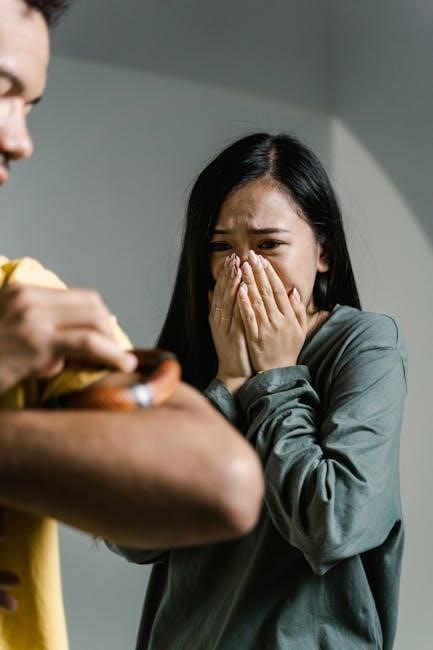The Liebowitz Social Anxiety Scale (LSAS) is a 24-item questionnaire developed by Dr. Michael R. Liebowitz in 1987 to assess social anxiety and avoidance behaviors. It evaluates fear and avoidance in various social situations‚ providing a comprehensive tool for clinicians and researchers to measure the severity of social anxiety disorder. Widely used in both clinical and research settings‚ the LSAS is valued for its ability to capture the complex nature of social anxiety‚ aiding in diagnosis and treatment planning. A modified version for children and adolescents is also available‚ ensuring its applicability across diverse populations.
1.1 Overview of Dr. Michael R. Liebowitz and the Development of LSAS
Dr. Michael R. Liebowitz‚ a renowned psychiatrist and researcher‚ developed the Liebowitz Social Anxiety Scale (LSAS) in 1987. Recognizing the need for a comprehensive tool to assess social anxiety‚ Liebowitz created a 24-item questionnaire to evaluate fear and avoidance behaviors in various social situations. His work addressed the complexity of social anxiety‚ providing a standardized measure for clinical and research use. Liebowitz’s contributions have significantly influenced the understanding and treatment of social anxiety disorder.
1.2 Importance of Assessing Social Anxiety
Assessing social anxiety is crucial for early detection‚ accurate diagnosis‚ and effective treatment planning. Untreated social anxiety can lead to significant impairment in daily life‚ relationships‚ and occupational functioning. The Liebowitz Social Anxiety Scale (LSAS) provides a standardized method to evaluate the severity of symptoms‚ enabling clinicians to monitor progress and tailor interventions. Early identification and intervention can prevent the escalation of symptoms and improve overall quality of life‚ reducing stigma and promoting mental health awareness.

Structure of the Liebowitz Social Anxiety Scale
The LSAS consists of 24 items assessing fear/anxiety and avoidance in social situations. Each item includes a fear/anxiety rating (0-3) and an avoidance rating (0-3)‚ evaluating social anxiety comprehensively.
2.1 Description of the 24-Item Questionnaire
The LSAS consists of 24 items‚ each evaluating a specific social situation. Respondents rate their fear/anxiety (0-3) and avoidance (0-3) for scenarios like public speaking‚ eating in front of others‚ or using public restrooms. This structured format allows for a detailed assessment of social anxiety symptoms‚ providing insights into both emotional distress and behavioral avoidance patterns across various contexts.
2.2 Fear or Anxiety and Avoidance Components
The LSAS evaluates both fear/anxiety and avoidance behaviors‚ each rated on a 0-3 scale. Fear/anxiety assesses the intensity of emotional distress in social situations‚ while avoidance measures the extent to which individuals avoid these situations. This dual-component approach provides a comprehensive understanding of social anxiety‚ distinguishing between emotional discomfort and behavioral avoidance‚ and aiding in tailored interventions.

Scoring and Interpretation of the LSAS
The LSAS is scored by summing ratings for fear/anxiety and avoidance‚ with total scores ranging from 0 to 144. Cutoff scores of 30 and 60 help identify social anxiety and generalized social anxiety disorder‚ respectively. This scoring system provides a clear framework for assessing symptom severity and guiding diagnosis.
3.1 Rating Scale for Fear and Avoidance
The LSAS uses a 4-point rating scale for both fear/anxiety and avoidance. Fear is rated as 0 (None)‚ 1 (Mild)‚ 2 (Moderate)‚ or 3 (Severe). Avoidance is rated as 0 (Never)‚ 1 (Occasionally)‚ 2 (Often)‚ or 3 (Usually). Each of the 24 social situations is assessed separately‚ allowing for a nuanced evaluation of symptom severity and avoidance behaviors. This dual rating system provides a comprehensive assessment of social anxiety symptoms;
3.2 Cutoff Scores for Social Anxiety Disorder
Cutoff scores of 30 and 60 on the LSAS-SR provide the best balance of sensitivity and specificity for classifying social anxiety disorder (SAD) and generalized SAD‚ respectively. These thresholds help clinicians and researchers identify individuals with clinically significant symptoms. Scores below 30 suggest mild or negligible social anxiety‚ while scores above 60 indicate severe and generalized social anxiety‚ requiring further evaluation and potential intervention.
Applications of the Liebowitz Social Anxiety Scale
The LSAS is widely used in clinical settings for diagnosing and monitoring social anxiety disorder. It is also a key tool in research‚ particularly for evaluating treatment efficacy in pharmacological and therapeutic trials. Additionally‚ a modified version of the scale is applied to assess social anxiety in children and adolescents‚ ensuring comprehensive evaluation across different age groups.
4.1 Use in Clinical Settings
The LSAS is extensively used in clinical settings to diagnose and monitor social anxiety disorder. Clinicians employ it to assess symptom severity‚ identify specific social situations triggering anxiety‚ and monitor treatment progress. Its structured format allows for consistent evaluation‚ aiding in tailored treatment planning and intervention strategies. This tool is particularly valuable for initial assessments and ongoing monitoring of patients with social anxiety disorder.
4.2 Role in Research and Treatment Trials
The LSAS plays a pivotal role in research and clinical trials‚ serving as a reliable outcome measure for assessing treatment efficacy. It is widely used to evaluate the effectiveness of both pharmacological and psychological interventions for social anxiety disorder. Researchers value its sensitivity to change‚ making it an essential tool for studying symptom reduction and long-term outcomes in treatment studies. Its application spans numerous clinical trials‚ contributing significantly to the advancement of social anxiety therapies.
Validity and Reliability of the LSAS
The LSAS demonstrates strong reliability and validity‚ making it a trusted instrument for assessing social anxiety. Its consistent performance across diverse populations solidifies its effectiveness.
5.1 Psychometric Properties of the Scale
The LSAS exhibits strong psychometric properties‚ with high test-retest reliability and internal consistency. It effectively measures both fear and avoidance dimensions‚ showing robust construct validity. Correlations with other anxiety scales further support its validity‚ making it a reliable tool for assessing social anxiety across clinical and research settings.
5.2 Comparison with Other Anxiety Assessment Tools
The LSAS is often compared to other anxiety assessment tools like the Social Phobia Inventory (SPIN) and the Social Interaction Anxiety Scale (SIAS). Unlike these‚ the LSAS uniquely assesses both fear and avoidance‚ providing a more comprehensive evaluation. Studies suggest the LSAS has higher sensitivity and specificity for diagnosing social anxiety disorder‚ particularly with its established cutoff scores. Its detailed structure makes it a preferred choice for both clinical practice and research studies.
The Liebowitz Social Anxiety Scale for Children and Adolescents
The LSAS has been adapted for younger populations‚ addressing developmental differences in social anxiety. This version includes 24 items‚ evaluating fear and avoidance in age-appropriate situations‚ ensuring accurate assessment of social anxiety in children and adolescents.
6.1 Modifications for Younger Populations
The LSAS for children and adolescents has been modified to reflect age-specific social situations. Items are simplified to suit younger comprehension‚ ensuring relevance to developmental stages. The scale maintains the original structure‚ assessing fear and avoidance‚ but uses language and scenarios appropriate for pediatric populations. This adaptation ensures accurate measurement of social anxiety in younger individuals‚ making it a valuable tool for child clinicians.
6.2 Assessing Social Anxiety in Developmental Stages
The LSAS for children and adolescents assesses social anxiety within developmental contexts‚ focusing on age-relevant situations like peer interactions and school-related fears. It evaluates how anxiety impacts daily functioning and developmental milestones. By addressing unique challenges at different stages‚ the scale helps identify early signs of social anxiety‚ enabling timely interventions. This tailored approach ensures comprehensive understanding and effective support for younger individuals.
Administering the LSAS
Provide clients with the LSAS scoring sheet and instruct them to rate their anxiety and avoidance for each situation based on their experiences in the past week. Ensure they answer all items consistently‚ especially if they have completed the scale before. Clear instructions help ensure accurate and reliable responses.
7.1 Instructions for Completing the Scale
Provide clear instructions to clients‚ ensuring they understand the 24-item format. Instruct them to rate fear/anxiety (0-3) and avoidance (0-3) for each situation‚ based on experiences in the past week. Emphasize consistency‚ especially if they have completed the scale before. Ensure they answer all items thoroughly‚ as incomplete responses may lead to inaccurate results. Clear guidance enhances reliability and validity of the assessment.
7.2 Guidelines for Interpretation
Interpret the LSAS by evaluating both fear/anxiety and avoidance subscales‚ each rated from 0 to 3. Total scores range from 0 to 144‚ with higher scores indicating greater impairment. Cutoff scores of 30 and 60 help identify social anxiety disorder and generalized social anxiety‚ respectively. Clinicians should consider both subscales together to assess symptom severity and guide diagnostic decisions. Interpretation requires clinical judgment and context to accurately reflect the client’s condition.

Limitations and Criticisms of the LSAS
The LSAS is a self-report tool‚ which may introduce subjectivity. Cultural biases and variability in symptom interpretation can affect scores. It relies on patient honesty and may not capture all clinical nuances.
8.1 Potential Biases and Cultural Factors
The LSAS may reflect cultural biases‚ as social norms and interpretations of anxiety vary across cultures. Self-reporting relies on individual perceptions‚ which can differ based on cultural background. Additionally‚ the scale’s development in Western contexts may limit its applicability to non-Western populations‚ potentially leading to misclassification of symptoms. Cultural sensitivity and adaptation are crucial for accurate assessment.
8.2 Self-Report Limitations
The LSAS relies on self-reporting‚ which may lead to biases in responses. Individuals may underreport or overreport symptoms due to personal biases‚ memory recall‚ or current emotional states. This subjective nature can affect the accuracy of assessments. Additionally‚ self-report measures may not fully capture the complexity of social anxiety‚ as they depend on the individual’s ability to introspect and report symptoms reliably.

Evolution and Updates to the LSAS
Developed in 1987 by Dr. Michael R. Liebowitz‚ the LSAS has undergone modifications‚ including adaptations for children and adolescents‚ ensuring its relevance and effectiveness in assessing social anxiety.
9.1 Historical Development and Revisions
Created by Dr. Michael R. Liebowitz in 1987‚ the LSAS was designed to assess social anxiety and avoidance behaviors. Initially a 24-item scale‚ it evaluates fear and avoidance in social situations. Over time‚ revisions included adaptations for children and adolescents‚ ensuring broader applicability. The scale has been validated across cultures and remains a reliable tool for diagnosing and monitoring social anxiety disorder in clinical and research settings.
9.2 Future Directions for the Scale
Future updates to the LSAS may involve integrating modern assessment techniques‚ such as digital platforms‚ to enhance accessibility and accuracy. Researchers are exploring adaptations to better capture nuanced cultural differences and expand its use across diverse populations. Additionally‚ efforts to refine the scale’s sensitivity to treatment changes could improve its utility in clinical trials. Continuous validation and adaptation will ensure the LSAS remains a reliable tool in evolving mental health landscapes.
The Liebowitz Social Anxiety Scale is a vital tool for assessing social anxiety‚ offering insights into fear and avoidance behaviors. Its reliability and versatility make it indispensable in both clinical and research settings‚ aiding in the diagnosis and treatment of social anxiety disorder across diverse populations‚ including adults and children.
10.1 Summary of the LSAS’s Role in Social Anxiety Assessment
The LSAS is a cornerstone in social anxiety assessment‚ providing a structured method to evaluate fear and avoidance behaviors. Its 24-item design allows for a nuanced understanding of how social anxiety impacts daily life. By distinguishing between fear and avoidance‚ the LSAS offers a dual perspective‚ enhancing diagnostic accuracy and treatment monitoring. This makes it a preferred tool for both clinical practice and research.
10;2 Final Thoughts on the Importance of the Liebowitz Social Anxiety Scale
The Liebowitz Social Anxiety Scale stands as a pivotal tool in mental health‚ offering a reliable and validated measure of social anxiety. Its dual assessment of fear and avoidance provides a comprehensive understanding‚ aiding in accurate diagnoses and effective treatment plans. The LSAS’s versatility across clinical and research settings underscores its enduring value in addressing social anxiety‚ making it an indispensable resource for professionals.



